AI-Powered CMMC Level 1 Tools: Which Checklist Gets You Audit-Ready?
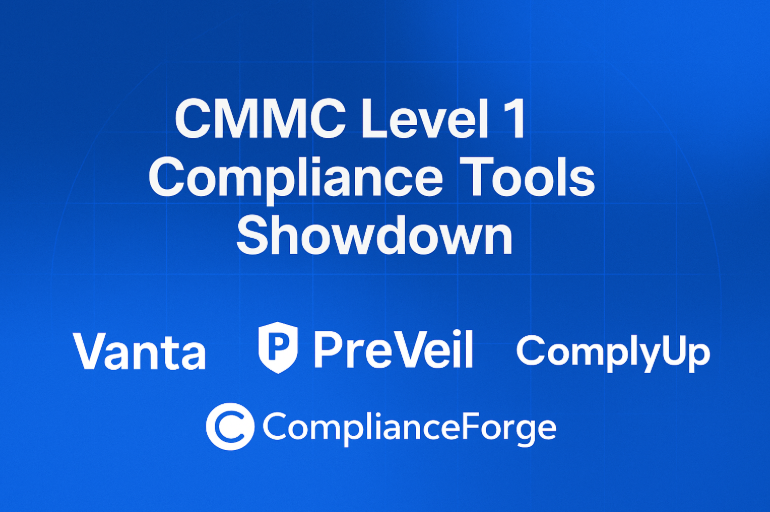
CMMC Level 1 compliance just got an AI upgrade. Large-language-model “co-pilots” inside today’s compliance platforms now auto-gather evidence, spot drift in minutes and even draft missing policies—exactly when the U.S.Department of Defense’s final CMMC 2.0 rule (published Sept 10 2025) starts appearing in contracts on Nov 10 2025. The stakes are high: the DIB counts more than 100,000 suppliers, yet a 2024 survey of global organizations found only 3% have a “mature” level of cybersecurity readiness.
This article shows how AI-first software—led by Vanta’s CMMC module, a handful of lean alternatives—turns the 15 “basic cyber-hygiene” practices into an always-green checklist you can export with one click.
What Level 1 really asks of you (and what AI now checks automatically)
Level 1 protects Federal Contract Information (FCI) via 15 controls such as MFA, antivirus and visitor logs. Modern platforms map each control to live telemetry. If Kevin disables MFA, an AI agent flags the gap instantly instead of months later at audit time.
Below you’ll find each habit in plain English, numbered for quick reference and paired with a one-sentence why. Pin the list to your wall; every tool we review later exists to keep these boxes green.
Limit log-ins. Only authorized users should access company systems.
Trim admin rights. Grant elevated privileges sparingly and review them often.
Lock down remote access. Secure VPNs or MFA must guard every off-site connection.
Separate public data. Keep information meant for your website away from internal networks.
Give everyone a unique ID. Shared accounts erase accountability.
Verify every login. Strong passwords plus MFA stop impostors at the door.
Sanitize retired hardware. Wipe or destroy drives before disposal or reuse.
Control physical entry. Servers and network gear belong behind locked doors.
Log and escort visitors. Guests sign in, wear badges, and never wander unaccompanied.
Guard the perimeter. Firewalls block unsolicited traffic at the network edge.
Isolate public-facing servers. Web assets stay in a demilitarized zone (DMZ), not your office LAN.
Patch without delay. Apply vendor fixes as soon as they arrive.
Run antivirus everywhere. Endpoint protection scans every device, every day.
Keep definitions current. Out-of-date engines miss new threats.
Scan for malware regularly. Scheduled sweeps catch files that slip through.
Prove these 15 practices happen continuously, and you pass Level 1. Modern compliance platforms can collect evidence automatically, flag missing patches, capture log entries, and even attach policy PDFs, letting you spend minutes verifying instead of hours hunting screenshots.
The DIY spreadsheet (still $5 977 in labor) vs. an AI co-pilot
The old way means significant staff-hours hunting screenshots and drafting policies. The new way: connect M365, your firewall and laptops, let an AI engine collect logs and draft missing docs, then review the dashboard over coffee. Real-world studies peg savings at 60-80 % of manual effort.
The do-it-yourself route.
Download the CMMC Level 1 spreadsheet, pour coffee, and start scrolling. That’s the classic DIY plan. You copy the 15 practices into rows and chase screenshots one device at a time.
The spreadsheet looks free, yet the Department of Defense estimates a Level 1 self-assessment costs around $5000. Someone must track where every laptop sits, which patches landed last night, and whether Kevin in accounting enabled multifactor authentication on his phone. Miss one row and the whole exercise unravels.
Paperwork piles on: policies, a system security plan, visitor logs. Each document starts blank. By the time you print the binder, payroll has matched a mid-tier software subscription, and you still risk missing a control because the guidance feels ambiguous.
Using a compliance tool
Picture the same checklist living in a browser tab that feels more like online banking than a government form. You connect Microsoft 365, your firewall, a few laptops, and the platform starts ticking boxes automatically.
Each practice appears as a plain-language task backed by live data. A new hire shows up without antivirus? The dashboard flips from green to red and emails a reminder. Close the gap and the color returns to green. Evidence such as log entries, screenshots, and policy PDFs files itself in the correct folder. When a prime contractor asks for your self-assessment, you click Export and send a polished report.
Why bother? Industry studies from CyberSaint show that compliance platforms cut 60–80 percent of manual effort and shrink audit prep from months to weeks. What once required evening “swivel-chair” audits now happens while you focus on engineering or payroll. The subscription fee buys back staff hours, reduces human error, and lets you bid with confidence that all 15 guardrails stay in place.
How to size up a compliance tool
Before we pick winners, we need a scorecard. A smart Level 1 solution hits four targets: ease of use, deep integrations, reliable reporting, and reasonable pricing. The next section explains each yardstick so you can judge any platform in five minutes.
Ease of use
If a dashboard looks like an airplane cockpit, keep shopping. Most Level 1 contractors have a part-time—or nonexistent—sysadmin, so good software must speak human, not National Institute of Standards and Technology (NIST) jargon. You should see a single progress bar, plain-English tasks, and one big button labeled Connect Microsoft 365. Every click must answer, “What do I fix next?”
According to an IDC study cited by Vanta, teams using automated compliance platforms spent 82 percent less time per framework thanks to simplified onboarding and task queues. If you still need a kickoff call just to run the first scan, the tool is not easy; it is overhead.
Integration capabilities
Compliance lives or dies on data. The more systems a platform can tap, the less grunt work lands on your desk. Leading tools now ship with more than 300 one-click connectors. According to Vanta, its own platform reached 350 integrations in 2025 with a varying number of new integrations added each month. Each additional connector eliminates a manual chore, whether it is verifying multifactor authentication in Microsoft 365 or checking endpoint-protection status in CrowdStrike, and turns that work into an automatic pass-fail test.
Breadth is only half the story; depth wins contracts. A shallow connector that only counts users still forces you to screenshot password-policy screens. A deep connector crawls configuration settings, security logs, and device health every few hours, creating living evidence instead of once-a-year snapshots.
Finally, watch the vendor’s release cadence. Quarterly connector drops signal a team committed to DoD’s moving targets; annual updates leave you catching up. Choose a tool that plugs into everything you run today and everything you might add tomorrow.
Reporting and audit prep
Level 1 still relies on self-attestation, but prime contractors will ask for proof. Your tool should let you export a polished CMMC packet in one click, complete with control status, last-evidence date, and linked artifacts—no midnight screenshot hunts. This kind of compliance reporting helps organizations continuously monitor and demonstrate adherence to security controls.
Look for:
Instant PDFs mapped to CMMC terms. Each page should show how a setting, such as MFA in Microsoft 365, satisfies a specific practice.
Share links. A live customer portal tops emailing 20-megabyte attachments every quarter.
Live health metrics. A real-time drop from 100 percent to 93 percent when someone disables antivirus gives you days to fix drift before a program office notices.
Bottom line: reporting is not just paperwork; it is the early-warning system that keeps contracts and revenue safe.
Cost-effectiveness
Sticker shock is real: entry-level compliance platforms often cost USD 3,000–6,000 per year for companies under 50 employees. A Forrester Total Economic Impact study on a compliance automation platform found that it delivered a 526% ROI over three years, with a payback period of just three months. Vanta customers report completing security reviews and questionnaires 81% faster, freeing dozens of billable hours each quarter.
When comparing plans:
Metering model. Some vendors bill per employee, others per connected asset. Forecast laptops, mailboxes, and cloud tenants twelve months out so growth does not trigger surprise overages.
Onboarding and support. Ask whether implementation help is included or sold as a separate service; a low sticker price plus consulting fees can top an all-inclusive tier.
Revenue risk. Losing a single USD 100,000 task order because a control slipped dwarfs any subscription fee. If you’re comparing vendors on more than just CMMC readiness, a compliance automation tools comparison can give a broader view of how different platforms deliver ROI across industries.
Do the math: if automation saves just 40 staff hours a year at USD 75 per hour, the labor savings alone offset a USD 3,000 license, and you still gain continuous, audit-ready evidence.
Tool-by-tool breakdown
We evaluated six popular options: Vanta, PreVeil, ComplianceForge templates, and ComplyUp. Each subsection explains what the tool does, where it shines for CMMC Level 1, and any trade-offs to weigh before you buy.
Vanta – autopilot with the Vanta AI Agent
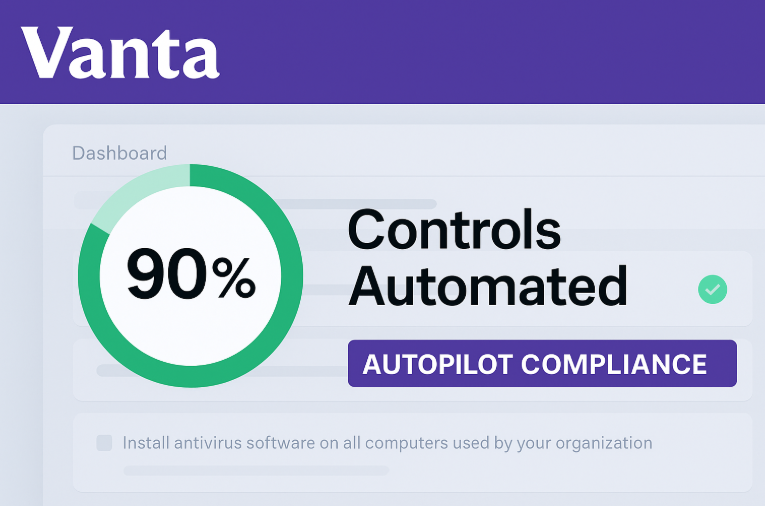
Vanta built its reputation on SOC 2 and now applies the same engine to CMMC. Connect Microsoft 365, AWS, or Jira—and the platform starts collecting evidence in minutes with Vanta CMMC. (hundreds of integrations; 1,200+ automated tests)
The dashboard behaves like a fitness tracker: one progress ring shows which of the 15 Level 1 practices are green. Click Antivirus to view every workstation plus any stragglers that missed the last scan. Close the gap, refresh, and watch the ring hit 100 percent.
Under the hood, Vanta automates up to 90 percent of control testing and ships editable policy templates for access control, media disposal, and more. Real-time alerts and one-click self-assessment exports turn annual audits into a quick coffee-break review.
Vanta customers have reported significant reductions in their security-review efforts after implementing the platform. For a small, cloud-heavy team, that beats wrestling spreadsheets at midnight.
PreVeil: instant encryption without leaving Outlook
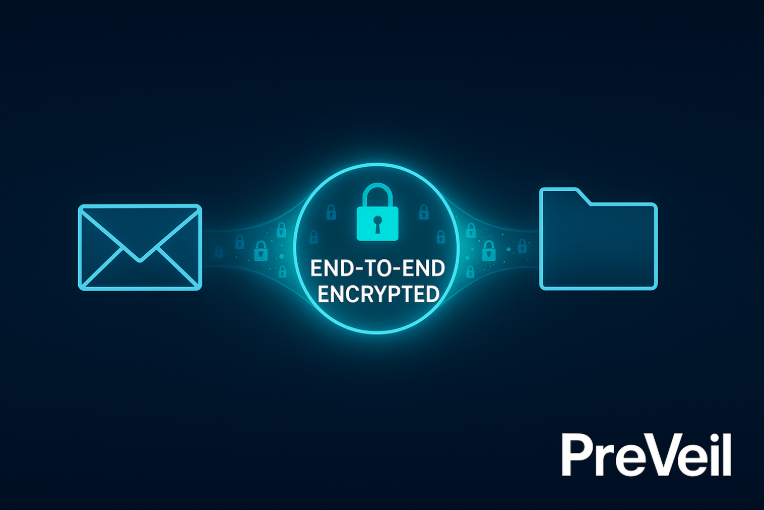
PreVeil is not a full GRC dashboard; it is an end-to-end encrypted mail and file system that bolts onto Outlook, Gmail, and mobile clients. Every message and attachment is locked by FIPS 140-2–validated crypto keys you control, and the service runs in AWS GovCloud to meet FedRAMP Moderate-equivalent requirements.
Why that matters for Level 1: four of the 15 practices focus on controlling system boundaries and protecting media. Email is the boundary many small contractors struggle with. PreVeil replaces “TLS-only” mail with zero-access encryption, yet users still click Send as usual.
Cost and speed are the hook. PreVeil advertises up to 75 percent savings versus migrating to GCC High and says most businesses onboard in under one day with no rip-and-replace migrations. The platform also ships a pre-filled system-security plan (SSP), policy templates, and one-on-one guidance, so pairing it with a lightweight checklist tool can close the toughest Level 1 gaps at a fraction of typical cloud-migration spend.
ComplianceForge templates: paperwork without the platform
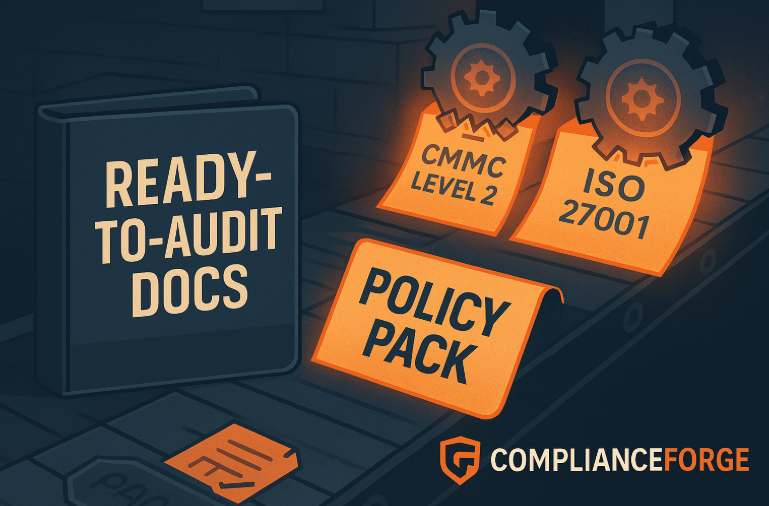
Some teams prefer editable Word files over SaaS dashboards. ComplianceForge sells exactly that: a library of professionally written policies, procedures, and system-security-plan templates mapped control-by-control to CMMC. The Level 1 bundle costs USD 5,344 one time and arrives in your inbox within one business day.
Download the ZIP, open Access-control policy, replace placeholders for company name, address, and owners, then repeat for the remaining docs. In a single afternoon you can assemble more than 120 pages of assessor-ready documentation—work that usually takes weeks.
No agents, no data leaving your network, and no recurring fees. Pair the templates with a free vulnerability scanner and a disciplined patch routine, and a micro-business can satisfy Level 1 requirements on a shoestring. Just remember: templates do not monitor anything; compliance lives or dies on how faithfully you follow the words you just edited.
ComplyUp: TurboTax for your self-assessment
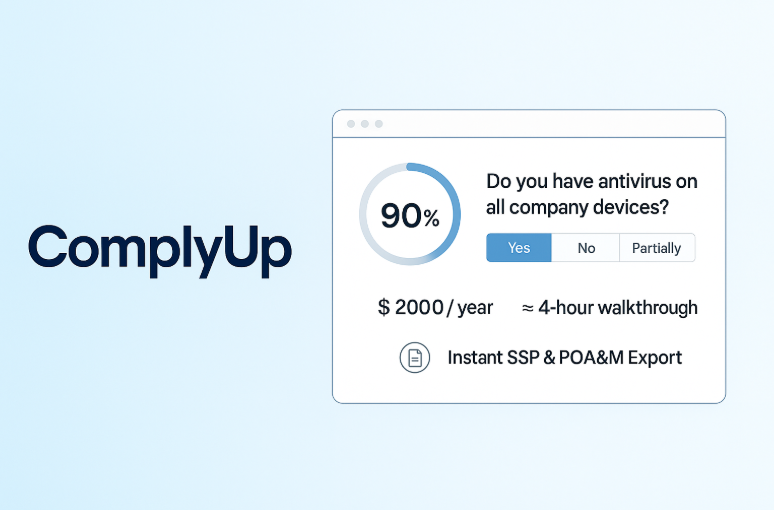
ComplyUp reduces CMMC to a Q&A wizard priced at USD 200 per year for Level 1, with a 30-day free trial. Log in and the screen asks, “Do you have antivirus on all company devices?” Choose Yes, No, or Partially, add a note, and the app scores you, builds a gap list, and auto-generates your SSP and POA&M.
The charm is minimalism: no agents, no connectors, just plain-English prompts. Reviewers say a five-person machine shop can finish the Level 1 walkthrough in about four hours, then export polished docs.
Remember, ComplyUp is point-in-time. You will still set calendar reminders, verify patches, and update answers yourself. But if you need an ultra-low-cost snapshot—and now the backing of parent company Exostar for future roadmap stability—ComplyUp diagnoses your posture faster than any spreadsheet.
Which tool fits your situation
Picture the people who will use the software every day and match their reality to one of these four snapshots:
Five-person parts shop, shoestring budget Spend about USD 5,500 once on ComplianceForge templates (USD 5,344) plus a USD 200 ComplyUp license. No monthly fees; schedule a 30-minute quarterly check to verify patches and visitor logs.
Twenty-employee engineering firm drowning in tasks Time tops cash. Vanta or Secureframe deploy in under one day and automate roughly 80 percent of evidence collection, saving 40–60 staff hours each quarter.
Fast-growing software vendor with nonstop DevOps Choose Drata. Its real-time GitHub and Jira hooks catch drift in minutes and support more than 300 integrations, perfect for teams shipping code around the clock.
Subcontractor emailing sensitive drawings daily Layer PreVeil on any of the above. End-to-end encryption satisfies boundary-protection controls and costs up to 75 percent less than migrating to GCC High.
Quick FAQ on CMMC tools
1. How expensive are these platforms?
Entry tiers run USD 3,000–6,000 per year for firms under 50 employees. A Forrester study shows automation can yield a 208 percent ROI and save more than 200 staff hours over three years.
2. Can I combine tools?
Yes. Many companies run Vanta or Drata for control monitoring and add PreVeil for encrypted email. Make sure you are not paying twice for identical features such as policy templates.
3. Will my Level 1 work be wasted if I move to Level 2 later?
No. The same 15 practices roll into Level 2’s 110 controls. Starting your Level 2 compliance journey with a Level 1 foundation can provide a significant head start, as the 15 Level 1 controls are also part of the 110 controls in Level 2.
4. Does software make me “certified”?
No. You still self-attest annually, but AI tools gather evidence so your executive can sign with confidence.
Conclusion
AI is already rewriting the CMMC playbook—turning what used to be a 22-hour screenshot hunt into a coffee-break dashboard check. The longer you wait, the more bids you’ll forfeit once contracting officers start enforcing the final rule on November 10, 2025.
Pick your co-pilot. Use the yard-sticks above to choose the platform (or low-cost template combo) that best fits your budget and tech stack.
Connect, remediate, repeat. Plug in M365, firewalls, and endpoints; let the AI surface gaps; close them fast. Watch that progress bar hit 100%.
Lock in your edge. Export your self-assessment, add “CMMC-ready” to proposal templates, and remind prospects that your security posture is verified—continuously, not just once a year.
Do that now, and CMMC shifts from compliance headache to competitive advantage—just in time for the next RFP to land in your inbox.


